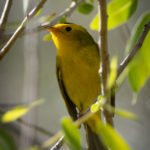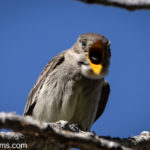The Rio Grande is a major western river that cuts through an inhospitable desert much like some of its counterparts. The San Juan and the Colorado rivers being good examples. From 30,000 feet, these rivers appear as mere threads cutting through a parched, dusty brown landscape and apart from some adjacent crop circles, do not reveal any indication of thier importance in sustaining life along their riparian edges or beyond. Closer to the ground and upon closer inspection, these edges support a massive number of species (not the least of which – humans) as they battle against the harsh desert elements.
Yesterday, a neighbor/friend and I grabbed our cameras and went down to the west bank of the Rio Grande and spent a few hours photographing birds in the Corrales Bosque Reserve not far from our homes. Here, in it’s current configuration (penned in by levees), the bosque is anywhere from a couple of hundred yards to maybe half a mile in width. It’s filled with native cottonwoods, willows and a tangled variety of understory vegetation. Like other areas of the west, the Bosque suffers from a number of invasive species that threaten native vegetation. In any case, when this vegetation leafs out in mid April, the place comes alive with migratory songbird activity.
While we saw over 20 different species of birds, the Wilson’s Warbler stole the show. These tiny, bright yellow birds with their distinctive black caps seemed to be everywhere. We also identified one bird that neither of us had previously seen. A Plumeous Vireo (not shown). Note the perfectly still and in-focus body of the Western Wood-Pewee as she swings her head at lightning speed to grab a passing insect that was also captured in the photo at 1/2000th of a second. Several other birds were identified only after careful consideration on the computer back at the home office. That’s the advantage of bird photography – being able to carefully analyze a picture (with a glass of good scotch, of course) and identify the bird without jumping to conclusions in the field.
Every single trip to the Bosque reveals an amazing amount of wildlife – anytime of year. However, the spring migration and nesting period is especially rich. It reminds me that these critters depend on us to preserve and maintain these native open spaces that are critical to their cycle of life. I often wonder – If people were more aware of this wildlife and it’s dependence on the Bosque, would they be as quick to take actions that threaten the Bosque? Just stand for a few quiet minutes in one place in the Bosque and this great variety of life will become evident – as will the importance of this place for us and the animals that live around us.



